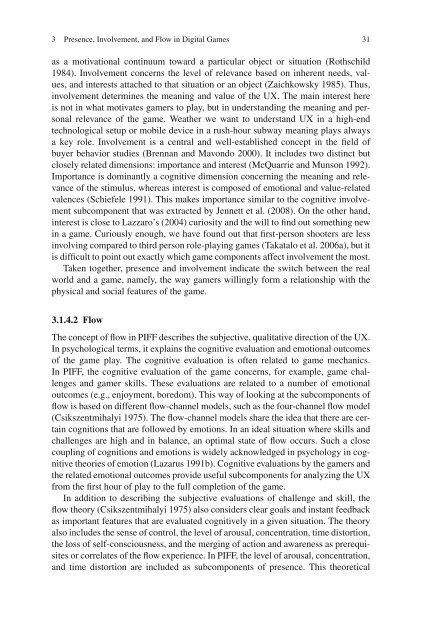Evaluating User Experience in Games: Concepts and Methods - Lirmm
Evaluating User Experience in Games: Concepts and Methods - Lirmm
Evaluating User Experience in Games: Concepts and Methods - Lirmm
Create successful ePaper yourself
Turn your PDF publications into a flip-book with our unique Google optimized e-Paper software.
3 Presence, Involvement, <strong>and</strong> Flow <strong>in</strong> Digital <strong>Games</strong> 31<br />
as a motivational cont<strong>in</strong>uum toward a particular object or situation (Rothschild<br />
1984). Involvement concerns the level of relevance based on <strong>in</strong>herent needs, values,<br />
<strong>and</strong> <strong>in</strong>terests attached to that situation or an object (Zaichkowsky 1985). Thus,<br />
<strong>in</strong>volvement determ<strong>in</strong>es the mean<strong>in</strong>g <strong>and</strong> value of the UX. The ma<strong>in</strong> <strong>in</strong>terest here<br />
is not <strong>in</strong> what motivates gamers to play, but <strong>in</strong> underst<strong>and</strong><strong>in</strong>g the mean<strong>in</strong>g <strong>and</strong> personal<br />
relevance of the game. Weather we want to underst<strong>and</strong> UX <strong>in</strong> a high-end<br />
technological setup or mobile device <strong>in</strong> a rush-hour subway mean<strong>in</strong>g plays always<br />
a key role. Involvement is a central <strong>and</strong> well-established concept <strong>in</strong> the field of<br />
buyer behavior studies (Brennan <strong>and</strong> Mavondo 2000). It <strong>in</strong>cludes two dist<strong>in</strong>ct but<br />
closely related dimensions: importance <strong>and</strong> <strong>in</strong>terest (McQuarrie <strong>and</strong> Munson 1992).<br />
Importance is dom<strong>in</strong>antly a cognitive dimension concern<strong>in</strong>g the mean<strong>in</strong>g <strong>and</strong> relevance<br />
of the stimulus, whereas <strong>in</strong>terest is composed of emotional <strong>and</strong> value-related<br />
valences (Schiefele 1991). This makes importance similar to the cognitive <strong>in</strong>volvement<br />
subcomponent that was extracted by Jennett et al. (2008). On the other h<strong>and</strong>,<br />
<strong>in</strong>terest is close to Lazzaro’s (2004) curiosity <strong>and</strong> the will to f<strong>in</strong>d out someth<strong>in</strong>g new<br />
<strong>in</strong> a game. Curiously enough, we have found out that first-person shooters are less<br />
<strong>in</strong>volv<strong>in</strong>g compared to third person role-play<strong>in</strong>g games (Takatalo et al. 2006a), but it<br />
is difficult to po<strong>in</strong>t out exactly which game components affect <strong>in</strong>volvement the most.<br />
Taken together, presence <strong>and</strong> <strong>in</strong>volvement <strong>in</strong>dicate the switch between the real<br />
world <strong>and</strong> a game, namely, the way gamers will<strong>in</strong>gly form a relationship with the<br />
physical <strong>and</strong> social features of the game.<br />
3.1.4.2 Flow<br />
The concept of flow <strong>in</strong> PIFF describes the subjective, qualitative direction of the UX.<br />
In psychological terms, it expla<strong>in</strong>s the cognitive evaluation <strong>and</strong> emotional outcomes<br />
of the game play. The cognitive evaluation is often related to game mechanics.<br />
In PIFF, the cognitive evaluation of the game concerns, for example, game challenges<br />
<strong>and</strong> gamer skills. These evaluations are related to a number of emotional<br />
outcomes (e.g., enjoyment, boredom). This way of look<strong>in</strong>g at the subcomponents of<br />
flow is based on different flow-channel models, such as the four-channel flow model<br />
(Csikszentmihalyi 1975). The flow-channel models share the idea that there are certa<strong>in</strong><br />
cognitions that are followed by emotions. In an ideal situation where skills <strong>and</strong><br />
challenges are high <strong>and</strong> <strong>in</strong> balance, an optimal state of flow occurs. Such a close<br />
coupl<strong>in</strong>g of cognitions <strong>and</strong> emotions is widely acknowledged <strong>in</strong> psychology <strong>in</strong> cognitive<br />
theories of emotion (Lazarus 1991b). Cognitive evaluations by the gamers <strong>and</strong><br />
the related emotional outcomes provide useful subcomponents for analyz<strong>in</strong>g the UX<br />
from the first hour of play to the full completion of the game.<br />
In addition to describ<strong>in</strong>g the subjective evaluations of challenge <strong>and</strong> skill, the<br />
flow theory (Csikszentmihalyi 1975) also considers clear goals <strong>and</strong> <strong>in</strong>stant feedback<br />
as important features that are evaluated cognitively <strong>in</strong> a given situation. The theory<br />
also <strong>in</strong>cludes the sense of control, the level of arousal, concentration, time distortion,<br />
the loss of self-consciousness, <strong>and</strong> the merg<strong>in</strong>g of action <strong>and</strong> awareness as prerequisites<br />
or correlates of the flow experience. In PIFF, the level of arousal, concentration,<br />
<strong>and</strong> time distortion are <strong>in</strong>cluded as subcomponents of presence. This theoretical

















